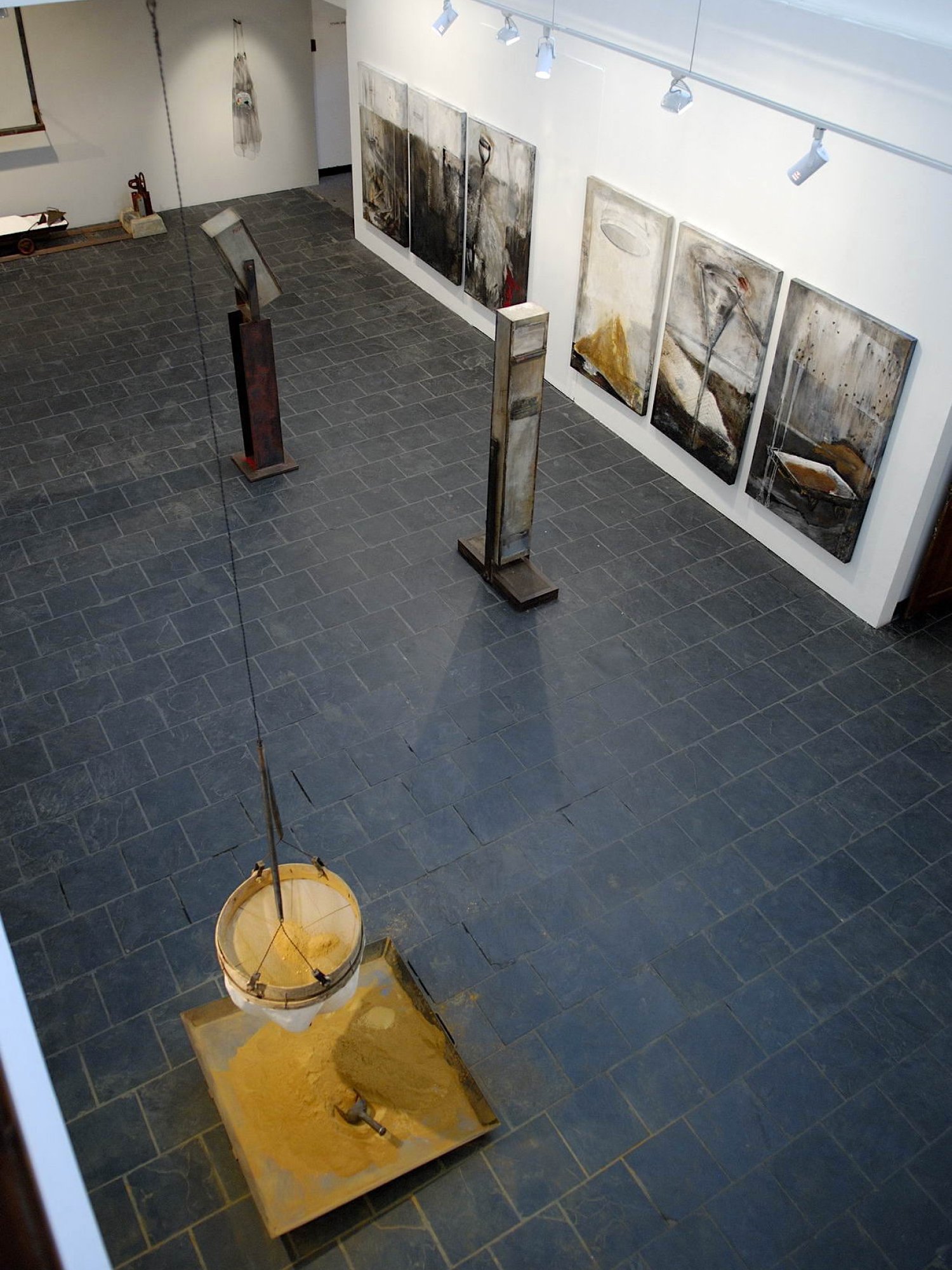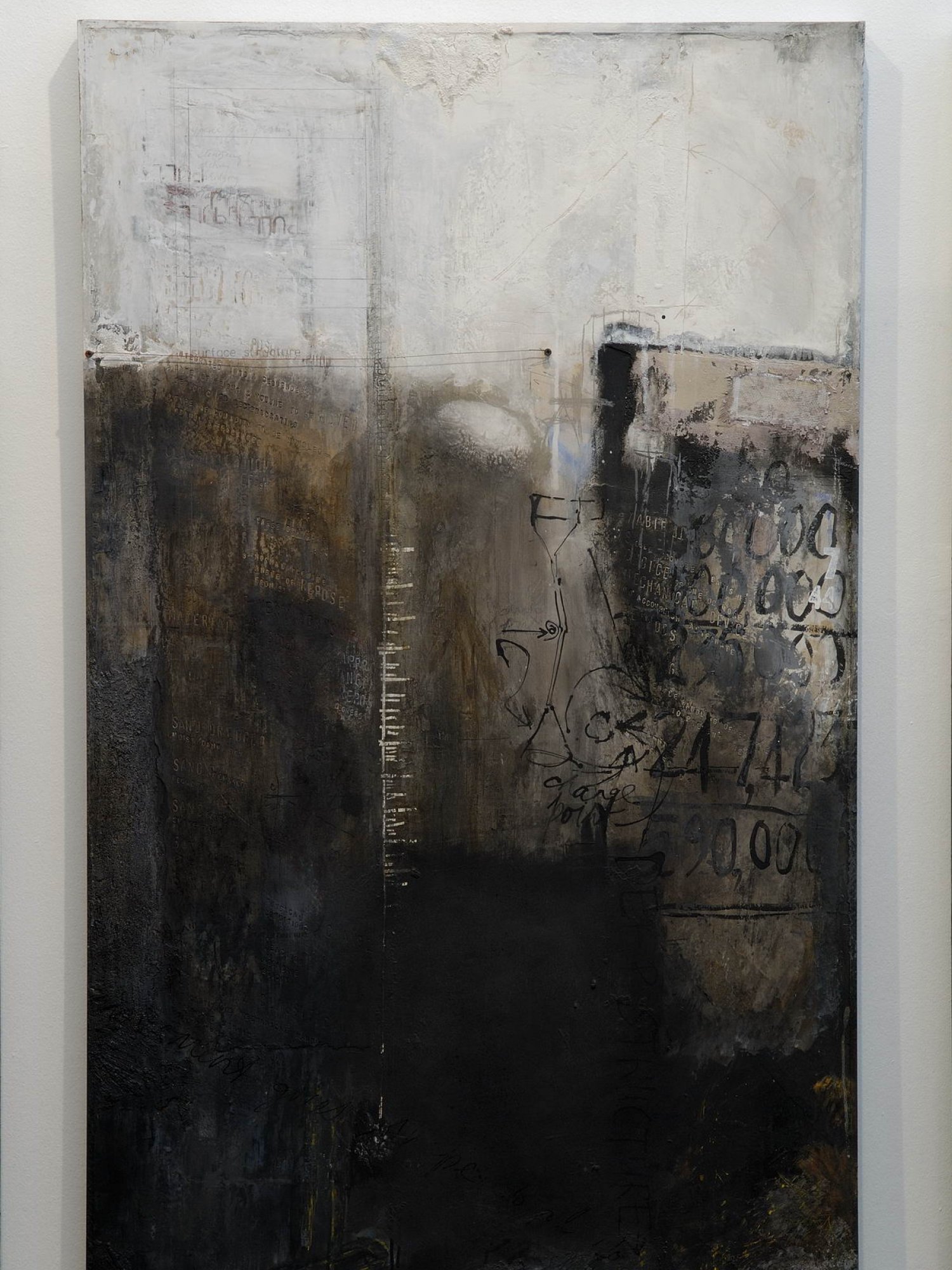SOLO EXHIBITION - 2006
Angle of repose
The angle of a hillside or a pile of deposited material, measured from the perpendicular, at which, based on the composition and adhesiveness of the material, the material may be said to be in a condition of stability. External conditions, such as rain or earthquakes, may affect the angle of repose.
Fig. 4. System for dredging, 2004
Found sieve and scoop, fabric, hooks and eyes, nuts and bolts, mild steel, cast iron wheels and yellow iron oxide
220 x 90 x 90 cm
4. System for dredging, 2004
Found sieve and scoop, fabric, hooks and eyes, nuts and bolts, mild steel, cast iron wheels and yellow iron oxide
220 x 90 x 90 cm
Fig. 6 System for stabilising, 2004
Mild steel, cast iron wheels, copper hooks, fabric, silver dredging spoon and cinnamon
115 x 71 x 66 cm
Overview
Overview
Fig. 1 System for funneling, 2004 Detail
Wood, found steel square and bolt, brass, lead, Plexiglas, acetate and salt
175 x 12.5 x 8.3 cm
Fig. 1 System for funneling, 2004 Detail
Wood, found steel square and bolt, brass, lead, Plexiglas, acetate and salt
175 x 12.5 x 8.3 cm
FIG. 2 System for excavating, 2004
Workbook development: sketches, technical drawings and mixed media on board
78 x 102 x 4.5 cm
Fig. 7 System for repose, 2004
Workbook development: sketches, technical drawings and mixed media on board
78 x 102 x 4.5 cm
Fig. 7 System for repose, 2004 Detail
Found objects, mild steel, cement, wood, lead, copper, yellow iron oxide and salt
88 x 300 x 26.2 cm
Fig. 1 System for funneling, 2006
Painting in mixed media on board
142 x 85.5 x 4.5 cm
Fig. 2 System for excavating, 2006
Painting in mixed media on board
142 x 85.5 x 4.5 cm
Fig. 4 System for dredging, 2006
Painting in mixed media on board
142 x 85.5 x 4.5 cm
Fig. 5 System for distribution, 2006
Painting in mixed media on board
142 x 85.5 x 4.5 cm
Fig. 6 System for stabilising, 2006
Painting in mixed media on board
142 x 85.5 x 4.5 cm
Fig. 7 System for repose, 2006
Painting in mixed media on board
142 x 170 x 4.5 cm
In this body of work, I explore the significance of the scientific principle known as ‘the angle of repose’. This principle can also be defined as ‘… the maximum angle to the horizontal at which substances (such as sand, rocks, salt and so on) will remain without sliding’. Therefore, whenever such granular substances are tipped out onto another surface, the way in which they naturally fall and come to rest is known as ‘the angle of repose’.
The word ‘repose’ reflects the pivotal theme in Angle of repose – in the process of observing, documenting and recording this phenomenon, many evocative and relevant visual metaphors for my personal situation and concerns became apparent. Conical and triangular shapes appear in the technical drawings and structures and in the heaps of poured substances. These shapes are, for me, vehicles of meaning which represent stability – however fragile – and a human quest for equilibrium.
Controlling structures consist of hard, rigid, intolerant materials such as cement, steel, wire and wood. With this equipment one can excavate, dredge, sieve, redistribute and funnel flowing substances such as salt, sugar, sand and oxide. The viewer is invited to participate in these actions and, in so doing, to contemplate the dichotomies between ‘repressive and free’; ‘rational and intuitive’; ‘pragmatic and romantic’ and ‘social and personal’. These loose substances show that the reposeful state is never static and emphasise the state of flux – a continual reassessing, adapting and reorganising, especially during the upheaval caused by dramatic and traumatic change. External intervention in life – human activities of destruction and re-construction – are inherent in attempts to create order out of chaos. Death, war and divorce come to mind, as do the radical political changes in our country that long for ‘a state of repose’.
Permutations of meaning are embedded in the symbolic significance of the materials. Steel, cement, wood and glass could represent strength, coldness and restraint, but they also corrode, break, crack and rot. Both salt and sugar can act as preservatives and enhance flavour; both are corrosive – but one represents suffering and the other comfort and happiness. Cinnamon is associated with smells of cooking and holds connotations of nurturing motherhood and warmth. It also represents sensual femininity and pleasure. Within the limited palette of the body of work yellow iron oxide is introduced as a symbol of brightness and illumination, representing new insights and joy.
The series concludes with a three-dimensional work, Fig. 7: System for repose, using many found objects chosen for the patina of time. It represents a fragile state of temporary equilibrium that hangs in the balance between harmony and chaos; between heavy and light; between Utopia and Hell. All of these works can and should be read on many levels: personal, social, political and universal.
Myles, K. & Associates. 2008. Bulk Conveying: Principles & Practice. Northcliff: K Myles & Associates.















